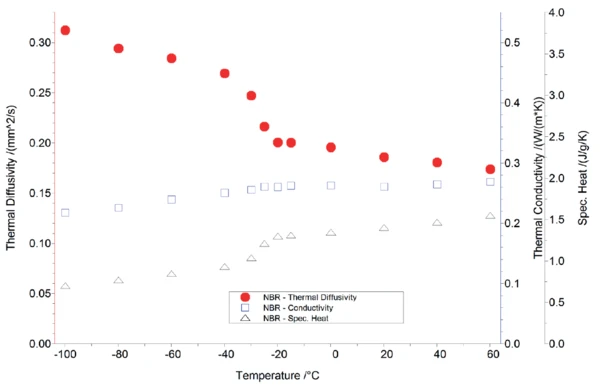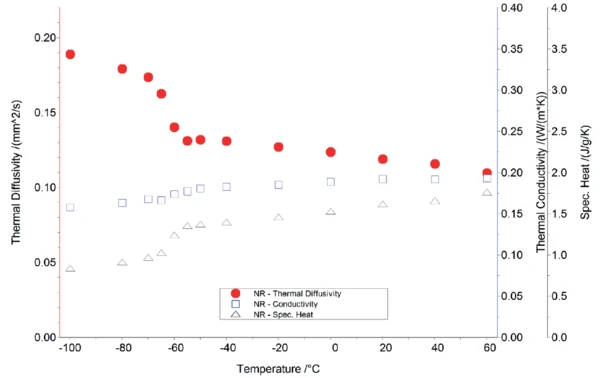Introduction
For elastomers, it is often the case that information is needed about the thermophysical properties below room temperature. The LFA 467 HyperFlash® can cover a temperature range of -100°C to 500°C with only one furnace.
The following measurements show the Conductividad TérmicaThermal conductivity (λ with the unit W/(m•K)) describes the transport of energy – in the form of heat – through a body of mass as the result of a temperature gradient (see fig. 1). According to the second law of thermodynamics, heat always flows in the direction of the lower temperature.thermal conductivity of two elastomers (NBR and NR) which were investigated between -100°C and 60°C. For measurements in the low-temperature range (T < 0°C), the MCT detector (mercury-cadmium-telluride) and the CC300 cooling system are needed; however, no modifications to the furnace are necessary. The Specific Heat Capacity (cp)Heat capacity is a material-specific physical quantity, determined by the amount of heat supplied to specimen, divided by the resulting temperature increase. The specific heat capacity is related to a unit mass of the specimen.specific heat capacity was determined by means of the DSC 204 F1 Phoenix®.
Figure 1 shows the Specific Heat Capacity (cp)Heat capacity is a material-specific physical quantity, determined by the amount of heat supplied to specimen, divided by the resulting temperature increase. The specific heat capacity is related to a unit mass of the specimen.specific heat capacity of both samples. Typical for elastomers, the Temperatura de Transición VítreaThe glass transition is one of the most important properties of amorphous and semi-crystalline materials, e.g., inorganic glasses, amorphous metals, polymers, pharmaceuticals and food ingredients, etc., and describes the temperature region where the mechanical properties of the materials change from hard and brittle to more soft, deformable or rubbery.glass transition was below RT (NR = -60.9°C; NBR = -26,8°C). The thermophysical properties of the elastomers are depicted in figures 2 and 3. The Temperatura de Transición VítreaThe glass transition is one of the most important properties of amorphous and semi-crystalline materials, e.g., inorganic glasses, amorphous metals, polymers, pharmaceuticals and food ingredients, etc., and describes the temperature region where the mechanical properties of the materials change from hard and brittle to more soft, deformable or rubbery.glass transition can be identified by means of the decrease in Difusividad TérmicaThermal diffusivity (a with the unit mm2/s) is a material-specific property for characterizing unsteady heat conduction. This value describes how quickly a material reacts to a change in temperature.thermal diffusivity. The Conductividad TérmicaThermal conductivity (λ with the unit W/(m•K)) describes the transport of energy – in the form of heat – through a body of mass as the result of a temperature gradient (see fig. 1). According to the second law of thermodynamics, heat always flows in the direction of the lower temperature.thermal conductivity, on the other hand, increases with increasing temperature almost linearly and exhibits no significant step.


